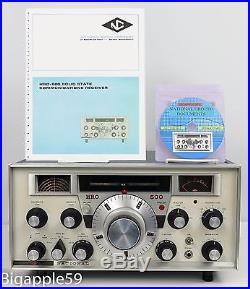
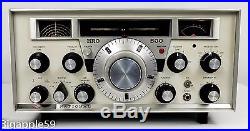
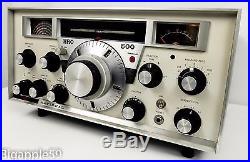
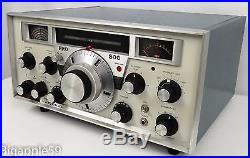
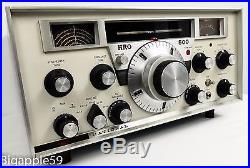
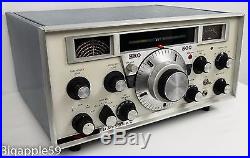

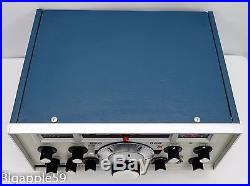
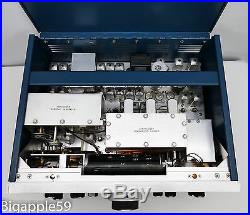
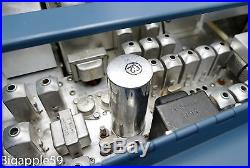

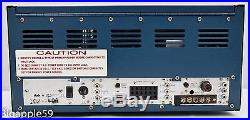

In the information below. This receiver is for the National HRO-500…. One of the all time classic boat anchors. It is one of the first all solid state receivers using germanium transistors instead of tubes. Despite this semiconductor manufacture, the unit is still heavy and tips the scale at 37 lbs. This is a scarce receiver (listed as very scarce in Osterman’s book Shortwave Receivers Past and Present), but it is even more scarce in this beautiful condition as you can see in the variety of HD pictures. In looking over the receiver, it is in fantastic cosmetic condition overall and probably the nicest HRO-500 that we have seen in some time. It is not a new receiver and there are some signs of use, but they are relatively minor as there are no dings, serious scratches, or other outstanding marks. What we did notice was a couple of minor marks on the left side cover, a couple of tiny scratches to the aluminum bezel on the top edge, and a few small specks of white paint on the right side (that our camera caught using enlarged pictures, but went unnoticed by our eyes). The front panel is in exceptional condition and the knobs, which generally have issues with the aluminum caps, look outstanding overall. This particular unit has serial number 102-409. Operationally, the receiver has been tested and performs marvelously. It locks on all 60 bands (of 500 KHz each) and displays good tuning accuracy and sensitivity. Typical deviation from band to band was about 1-2 KHz which was easily calibrated and should be within HRO’s factory specs. We did notice that when locking the synthesizer, that a handful of bands did not display the number completely in the window. In other words, you would see the number, but on 5 or 6 bands, to obtain “lock” with the red light out you had to tune so that the number was not fully seen in the window (as we have tried to show in the pictures for this listing showing 9 MHz). This number is visible when viewing the receiver slightly downward. This minor issue is not a problem during use and would likely be resolved with an alignment and such alignment may also serve to improve the already good sensitivity. It must be common as it was something that we encountered in our previous HRO-500 receivers. Included with this receiver is a 60 page manual. In addition, the new owner will also get some history of the National Company and a review of the HRO-500 as found in Popular Electronics in 1965 that considers whether the HRO-500 is “the greatest receiver ever made”. Other items included are the AC power cord and a CD that contains a copy of the manual and copy of the Popular Electronics review. The price of this receiver has been established in accordance with relative scarcity and physical condition. Let us give you some historical information about this receiver. National Radio Company began doing research in the early 1960s for a completely solid state radio. Engineers began work on this totally new receiver and worked to provide a cutting edge unit that was a natural progression from it’s tube receivers produced since the 1930s. The result of this research was the wonderful HRO-500 communications receiver. It was a real departure from competitive receivers produced by Hammarlund and Hallicrafters and displayed a contemporary American industrial design that was cutting edge for items originating from the USA during that era. Cosmetically, the HRO-500 did not resemble it’s earlier HRO counterparts. The familiar National micrometer dial was retained and this linked the HRO-500 back to the some of the earliest National receivers. But the dial was updated giving a sleek metallic look that complimented the symmetrical front panel layout. All of the controls were designed to allow the receiver to be operated with ease (relative to that day) and a minimal searching for the proper controls. While the HRO-500 was updated externally, the real change was hidden beneath the metal cabinet. It was here that the engineers at National applied some real changes. Rather than taking traditional design based on vacuum tubes and incorporating changes, the engineers made a complete break with the past and utilized the latest state-of-the-art electronic design philosophies. Up until that time, commercial receivers relied on a variable frequency oscillator for tuning. Despite the achievements and improvements in this circuit, the oscillator could not be completely stable with respect to frequency. Variable oscillators were subject to drift from the tuned frequency and frequent re-tuning was necessary. Crystal controlled oscillators could offer stability, but since they could be tuned to only one frequency, this presented another set of obstacles. The designers of the HRO-500 solved this dilemma by using a frequency synthesized circuit. The synthesizer based on a stable crystal oscillator produced the necessary frequencies that would normally be generated by a variable oscillator. Thus, the crystal oscillator determined the overall stability of the synthesizer and this virtually eliminated inaccuracy and drift since the synthesizer was “phase locked” to the crystal oscillator. As a result, the HRO-500 was so stable that it’s drift was measured at less than 10 Hz in any ten minute period and the receiving circuit could be used as a frequency counter. This design was innovative, but complex, and demonstrates a fine example of early solid state excellence using point to point wiring. With this design, the HRO-500 could be tuned to any one of 60 bands using a 500 KHz width across it’s tuning range of 5 KHz to 30 MHz and with an accuracy of 1 KHz across the entire spectrum shown in 1/4 increments. Only the military Collins designed R390A could equal such an engineering feat. With this accuracy, the operator could dial up a particular frequency and be assured that the receiver was tuned to that frequency before transmission…. And remain nailed to that frequency during the duration of transmission. The micrometer tuning further gave a comparable tuning bandspread length of 24 feet per MHz…. Enormous precision by any receiver standards. About 1440 feet of total tuning bandspread across it’s full tuning range!!! Other advanced features were found in the HRO-500 including. A passband filter to minimize QRM and for accurate tuning of single sideband signals. Flat response across the audio spectrum (100 Hz to 5500 Hz within 6 dB). A true product dectector circuit for single sideband reception. Complete solid-state circuitry using 37 transistors offering minimum heat and power requirements and a long MTBF (mean-time-between-failure was an outstanding 3820 hours using proper derating of components). Four selectable “tuneable” bandwidths of 500 Hz / 2.5 / 5.0 / 8.0 KHz. Instant “on” with no warm up. Sensitivity & image rejection average of 80 dB superior to previous. Standard of comparison – other HRO receivers. Selectable tuning ratio of 10 KHz or 50 KHz per revolution of main tuning control (for fine tuning or rapid band-scanning). Frequency range from 5 KHz to 30 MHz in 60 bands. Power source of 115/230 VAC or 12 VDC (DC does not require an external power supply). Complete remote control provisions including AF gain, RF gain, BFO on-off, receiver mute, and power on-off. All necessary oscillator, AGC, IF and detector outputs provided for use with accessory equipment. National had hoped that the HRO-500 would revive the company’s failing fortunes. And while it was well received by the public… According to Ray Moore in his book Communications Receivers, 4th ed. Perhaps it was a little ahead of it’s time. The HRO-500 was popular and widely admired…. The HRO-500 immediately became the ultimate receiver. Unfortunately, it did not save National…. The Japanese were waiting in the wings. The HRO-500 continued in production through late 1972 when it was discontinued and replaced with it’s successor…. Today, the HRO-500 is found in limited numbers and has a mystique among radio collectors who prize it perhaps even more than when it was manufactured. We had a lot of fun in re-discovering this receiver and it was enjoyable tuning and playing with this receiver during the time it has been in our possession. They don’t make receivers like this anymore and this is truly a joy to operate requiring the user to select the proper band, preselector range, tune the preselector, and proper frequency. Thus, if you like the direct dial automatic tuning, you will not find the joy of operating such a receiver that is akin to driving an automobile with a clutch instead of an automatic transmission! At this point, we think we have covered all the pertinent details concerning this HRO-500 receiver. Due to the fragile nature of this receiver, it will be well packed using plenty of protective packaging and in a good size sturdy box. Potential buyers outside the USA are reminded that this is a very heavy receiver. The item “National Radio HRO-500 Shortwave Ham Receiver AM SSB CW BEAUTIFUL UNIT” is in sale since Thursday, June 30, 2016. This item is in the category “Consumer Electronics\Radio Communication\Ham, Amateur Radio\Ham Radio Receivers”. The seller is “bigapple59″ and is located in Lamar, Pennsylvania. This item can be shipped worldwide.
- Type: Base Station
- Brand: National Radio
- Model: HRO-500
- MPN: HRO-500
- Frequency Band(s): HF
- Supported Modes: AM
- Country of Manufacture: United States

